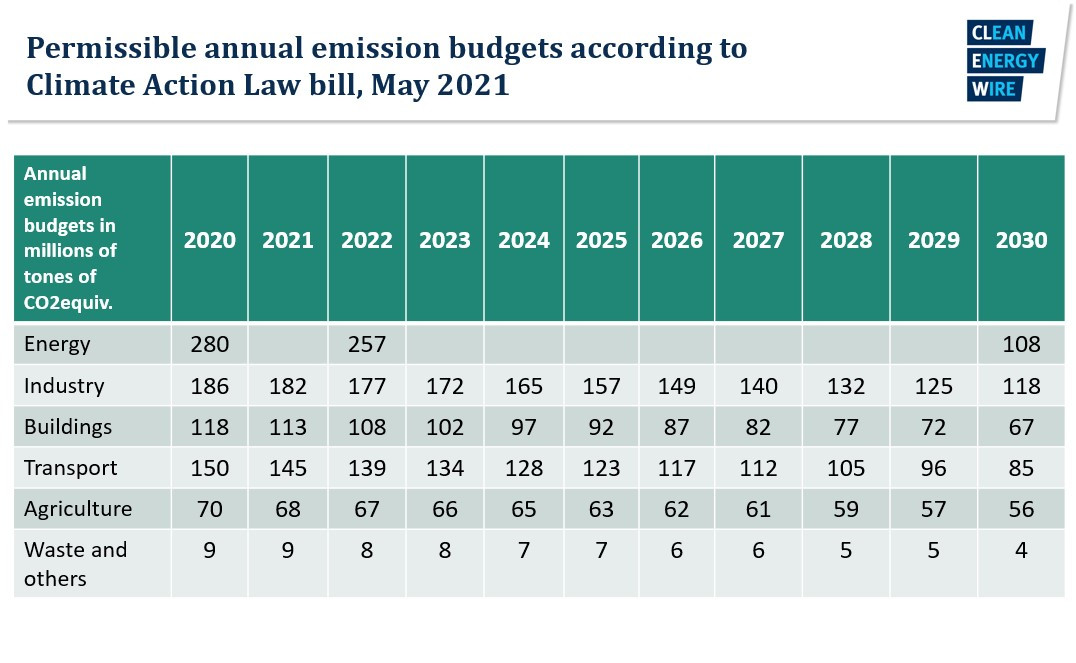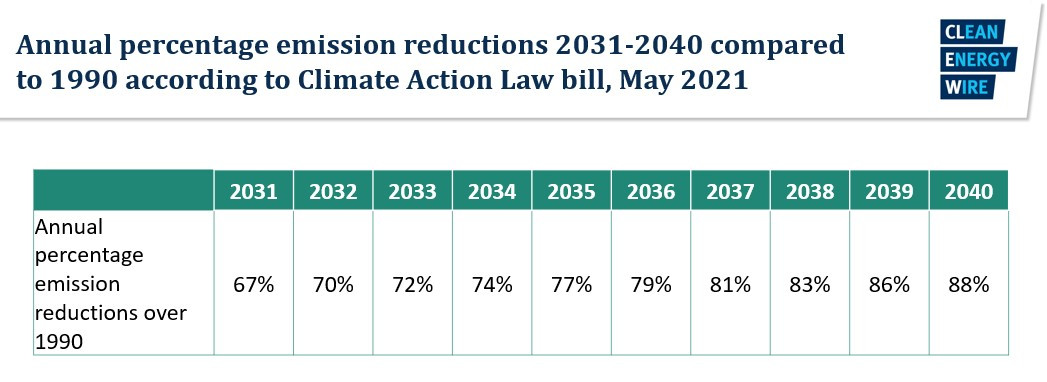Cabinet decides climate law reform, tougher sector emission budgets included
Less than two weeks after Germany’s highest court ruled parts of the country’s Climate Action Law as insufficient, the government cabinet in Berlin decided on a reform of the 2019 act. Outlining the major changes intended, environment minister Svenja Schulze and finance minister Olaf Scholz (both Social Democrats, SPD) said that this will significantly raise the country’s greenhouse gas reduction targets and aim for climate neutrality as early 2045 and for negative emissions after 2050. The proposal also includes the targets of reducing greenhouse gas emissions by 65 percent by 2030 (current target: 55%) and by 88 percent by 2040 (currently no target). Bringing the net zero target forward to 2045 was applauded by other countries, but German industry has voiced its concerns over targets being too strict and the “hectic tightening of national climate targets” which increases uncertainty for business and consumers.
The bill shows that the energy industry will have to shoulder the bulk of additional emission reductions by 2030. Instead of 175 million tonnes CO2 equivalent – the current target – it will only be allowed to emit 108 million tonnes. Industry is supposed to reduce emissions to 118 million tonnes (current target: 140 mt).
The environment ministry reasons that the industrial and energy sectors continue to be the sectors with the highest emissions and at the same time they are key for emission reductions in all sectors “due to the importance of the electrification of end-use sectors”. Targeting them also follows the “economic idea of reducing where the abatement costs are lowest”, the bill says.
For the time after 2030, the bill introduces annual percentage greenhouse gas reduction targets until 2040, ranging from minus 68 percent in 2031 to minus 88 percent in 2040. The individual sectoral emission budgets for this period are to be set by the government in 2024.
In 2032 and 2034, the government will determine the greenhouse gas reduction targets and emission budgets of the different sectors for the period from 2041 to 2045, according to the draft.
Another novelty is the inclusion of negative emission targets for the land use, land use change and forestry sector in the law. On average, the sector shall provide a sink for 25 million tonnes of CO2equiv. by 2030 and 40 million tonnes by 2045. After having been severely damaged by heat waves and droughts in recent years, German forests may however not be in the condition to contribute much to CO2 uptake, researchers have warned.
Germany’s current governing coalition of chancellor Angela Merkel’s conservatives (CDU/CSU) and the Social Democrats (SPD) introduced the country’s first major climate law with binding emissions reduction targets for the 2020s as part of a comprehensive package of measures in 2019. The package was meant to ensure that Germany reaches its 2030 targets, but the climate action law also included a line on “pursuing” the long-term target of greenhouse gas neutrality by 2050. However, it postponed the decision on emissions reduction targets post-2030 to a later date, which is the reason why the Federal Constitutional Court found fault with the law.
NGO initiative Climate Action Tracker commented on the new Climate Action Law that the new proposed targets “are not quite there yet in terms of Paris Agreement compatibility”. Niklas Höhne of the NewClimate Institute said: “Our 1.5˚C benchmark modelling shows the government’s targets for coal, renewables and especially transport are deficient.” The 2030 target would have to be at least a 69 percent reduction in greenhouse gases and the target for renewables use in electricity generation need to be around 90 percent or more by 2030, the NGO said.
New target not enough to be "Paris Agreement compatible" - NGO
The Association of Energy Market Innovators (BNE) also stressed the need for more and faster renewables expansion. “In view of the new targets, the expansion path of renewable energies should be raised to 75 – 80 percent by 2030”, BNE head Robert Busch said. But targets alone are not enough. Accordingly, the expansion paths and tender quantities for wind and solar energy in the EEG must be significantly adjusted as "early transparent measures".
Energy industry association VIK’s managing director Christian Seyfert criticised the “tightening of the targets at short notice with a view on the general election and without the necessary cost and technology impact assessments”. He said this creates “planning uncertainty and shakes the industry's confidence in the long-term consistency of German climate protection policy”.
Germany’s greenhouse gas emissions dropped nearly nine percent in 2020 - the largest annual fall since 1990 - as the effects of the COVID-19 pandemic pushed down the use of fossil fuels and added to the effects of the shift to renewable energy sources, mild weather and rising CO2 prices. Estimates released by the Federal Environment Agency (UBA) showed that emissions fell in all economic sectors, most notably in energy and transport. Most sectors have reached their emissions reduction targets for 2020 and Germany's overall goal of a 40 percent emission reduction over 1990 was met, but the new targets of the Climate Action Law still appear ambitious when considering that much of the emission reductions in particular in the transport sector were due to lock downs during the pandemic.




